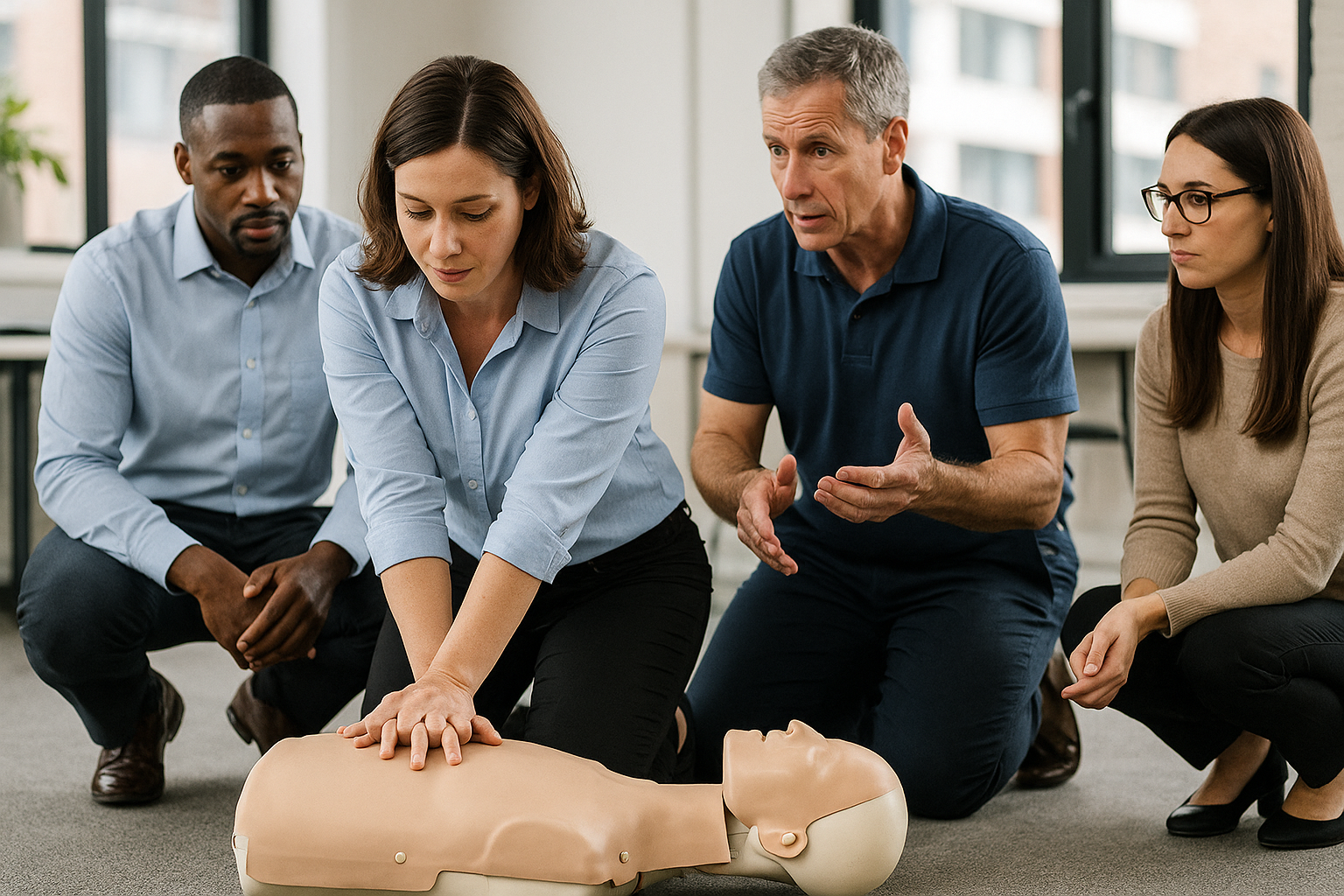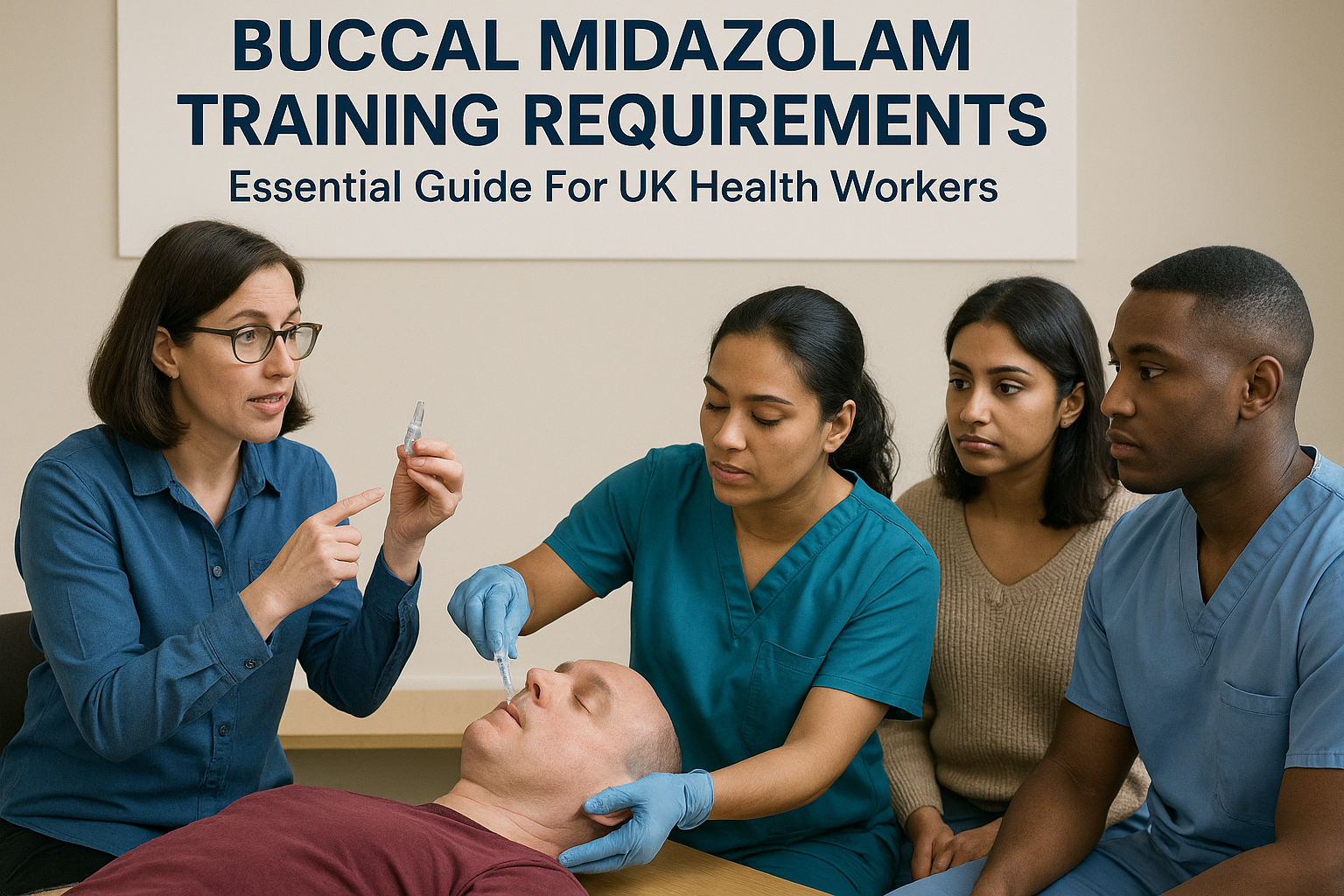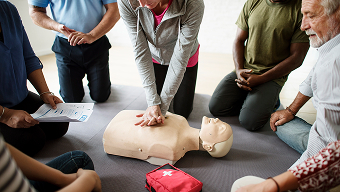Why CPR Skills Matter at Work


Professional CPR Training Courses - UK Certified Programs
When a colleague collapses at work, the first three minutes determine whether they survive—and whether your team can act with confidence or freeze in panic. CPR training transforms bystanders into lifesavers, but choosing the right course means navigating regulations, certification standards, and practical delivery options across the UK.
This guide covers why CPR skills matter in the workplace, UK compliance requirements, course formats for different settings, and how to select training that builds real competence rather than just ticking boxes.
Why CPR Skills Matter at Work
CPR training in the UK is available through various providers for workplaces and the general public, with courses offered both on-site and online to meet Health and Safety Executive (HSE) standards. Organizations across healthcare, education, facilities management, and corporate sectors rely on accredited training to prepare staff for cardiac emergencies. Whether you're looking for basic public courses or comprehensive workplace certification, the right training equips your team with practical, life-saving skills.
Cardiac emergencies happen suddenly—in offices, warehouses, schools, and public spaces—often without any warning signs. When someone collapses from cardiac arrest, the first few minutes determine whether they survive. High-quality CPR delivered immediately, combined with early defibrillation, can double or even triple the chance of survival before paramedics arrive.
Adult and Paediatric Cardiac Arrest Statistics
Over 30,000 out-of-hospital cardiac arrests occur in the UK each year, and survival depends heavily on bystander intervention. The chain of survival—early recognition, immediate CPR, rapid defibrillation, and advanced care—starts with trained individuals who can act without hesitation. Cardiac arrest strikes in retail stores, construction sites, gyms, and care homes with equal unpredictability.
Children and infants require different CPR techniques compared to adults. Compression depth, hand placement, and the ratio of compressions to rescue breaths all vary by age group. Paediatric training covers adaptations like shallower compressions, modified hand positions, and adjusted breath ratios—essential knowledge for schools, nurseries, sports clubs, and family-oriented businesses.
Legal and Moral Duty of Care
Employers carry responsibilities under the Health and Safety at Work etc. Act 1974 to provide adequate first aid arrangements based on workplace risk. CPR training forms a core part of that duty, particularly in environments where cardiac events are statistically likely or where vulnerable populations are present.
Beyond legal compliance, there's a moral imperative. Organizations have an ethical obligation to protect employees, contractors, and visitors by enabling a rapid, competent response to life-threatening emergencies. When someone collapses, trained staff don't freeze—they act with confidence and purpose.
UK Regulations and Certification Requirements
UK guidance makes CPR and first aid training mandatory or strongly recommended depending on your workplace risk profile and sector. Regulators expect staff to maintain competence through recognized, quality-assured training and regular assessment.
HSE Guidelines for Workplace First Aid
The Health and Safety Executive (HSE) requires employers to conduct a first aid needs assessment and ensure "adequate and appropriate" provision. This assessment considers factors like workforce size, workplace hazards, shift patterns, and proximity to emergency services.
Training comes from competent providers with quality assurance from approved awarding bodies, covering CPR and AED use where your assessment indicates they're necessary. For many workplaces, Emergency First Aid at Work (EFAW) or First Aid at Work (FAW) courses include CPR as a core component.
CQC and Ofsted Expectations for Care and Education Settings
Care Quality Commission (CQC)-regulated services verify that staff are suitably trained and competent in life support appropriate to their role and the people they support. Inspectors review training records, competency assessments, and how quickly staff can respond to medical emergencies.
Ofsted expects early years providers and schools to have paediatric first aid (including paediatric CPR) in line with the statutory framework for the Early Years Foundation Stage. At least one person with a current paediatric first aid certificate stays on the premises and available at all times when children are present.
Certificate Validity and Renewal Rules
Most workplace first aid and CPR certificates remain valid for three years from the date of issue. Yet skills degrade over time—research shows that compression quality and AED confidence decline significantly within 12 months without practice. Annual refreshers help maintain competence, with formal requalification required before your certificate expires.
Some roles, particularly in healthcare settings, may require more frequent updates based on employer policy, professional standards, or clinical governance frameworks. Keeping a training matrix helps track expiry dates and plan renewals without gaps in coverage.
Course Options for Businesses and Professionals
CPR training pathways are designed for different workplace contexts, from general office environments to specialized healthcare and childcare settings. Choosing the right course depends on the risks you've identified, the age groups you serve, and any sector-specific regulatory requirements.
Workplace CPR and AED
This practical, entry-level course covers adult CPR, safe AED use, choking response, and recovery position. Participants learn correct hand placement, compression depth (5–6 cm), compression rate (100–120 per minute), and the 30:2 ratio of compressions to rescue breaths. The course works well for offices, retail, hospitality, manufacturing, and public venues where adult casualties are the primary concern.
Training includes realistic practice on adult manikins and AED trainers, with scenarios that replicate the stress and decision-making of real emergencies. Learners also practice choking interventions—back blows and abdominal thrusts—and placing unconscious but breathing casualties in the recovery position.
Paediatric CPR
Specialized training focusing on infants (under one year) and children (one to puberty) covers age-specific techniques essential for schools, nurseries, sports clubs, and child-focused organizations. Paediatric CPR differs significantly from adult techniques: compression depth is shallower, hand placement varies (one or two hands for children, two fingers for infants), and the compression-to-breath ratio may differ depending on whether you're a lone rescuer or part of a team.
Participants practice on infant and child manikins, learning to assess responsiveness, open airways safely, and deliver effective rescue breaths. Choking management for infants includes back blows and chest thrusts rather than abdominal thrusts, which could cause internal injury.
Basic Life Support for Healthcare
BLS for healthcare workers covers adult and paediatric CPR, AED use, airway management, and team-based resuscitation scenarios aligned to clinical practice. This course meets the requirements of the UK Core Skills Training Framework and works for nurses, doctors, allied health professionals, care home staff, and ambulance personnel.
Training includes oxygen therapy (where applicable), bag-valve-mask ventilation, and coordinated team roles during resuscitation. Scenarios emphasize communication, leadership, and handover to advanced life support teams.
Blended and Online Refresher Paths
Blended learning combines online theory modules with a short, hands-on practical assessment session. Learners complete knowledge components at their own pace, then attend a condensed in-person session to demonstrate competence on manikins and AED trainers. This format meets HSE expectations for practical evaluation while minimizing time away from work.
Online-only courses can't replace hands-on practice for workplace compliance, but they're useful for theoretical refreshers between formal certifications or for public awareness. Always verify that any blended course includes a face-to-face practical component assessed by a qualified instructor.
Skills Covered in a Certified CPR Course
CPR training is hands-on and scenario-led, building confidence and muscle memory for real emergencies. Courses emphasize practical skills over theoretical knowledge, with repeated practice until movements become automatic.
Primary Survey and Calling 999
The primary survey—often taught as DRSABC (Danger, Response, Shout, Airway, Breathing, Circulation)—provides a systematic approach to assessing any casualty. First, you check for hazards. Then you assess responsiveness by speaking loudly and gently shaking the shoulders. Next, you shout for help while checking for normal breathing.
Calling 999 effectively means providing clear, concise information: your location (with landmarks or postcode), what happened, the casualty's condition, and whether an AED is available. Staying on the line allows the call handler to guide you through CPR if needed.
Chest Compressions and Rescue Breaths
Correct hand placement—center of the chest, lower half of the sternum—ensures compressions are effective without causing unnecessary injury. Compressions go 5–6 cm deep for adults, delivered at 100–120 per minute (roughly the tempo of "Stayin' Alive" by the Bee Gees). After every 30 compressions, you deliver two rescue breaths by tilting the head back, lifting the chin, and sealing your mouth over the casualty's.
Paediatric adaptations include:
- Shallower compressions: About one-third of chest depth instead of 5–6 cm
- Modified hand placement: One or two hands for children depending on their size, two fingers for infants
- Adjusted rescue breaths: Cover both the nose and mouth with your mouth for infants, creating a seal
Automated External Defibrillator Use
AEDs are designed for use by anyone, with clear voice prompts guiding each step. You switch on the device, expose the casualty's chest (removing clothing and drying if wet), and place pads according to the diagrams on the pads themselves. The AED analyzes the heart rhythm and advises whether a shock is needed.
When the AED instructs you to stand clear, you verify no one is touching the casualty before pressing the shock button. Immediately after the shock, you resume chest compressions without delay. Courses also cover troubleshooting—what to do if pads won't stick, how to check battery status, and when to replace consumables.
Choking Management and Recovery Position
Recognizing the difference between mild and severe airway obstruction is critical. Mild obstruction (casualty can cough and speak) requires encouragement to cough. Severe obstruction (silent, unable to breathe) demands immediate back blows and abdominal thrusts. For infants, you use back blows and chest thrusts instead of abdominal thrusts.
The recovery position keeps an unconscious but breathing casualty's airway open and allows fluids to drain from the mouth. You practice rolling casualties safely onto their side, supporting the head, and checking breathing regularly.
Course Format and Duration Explained
Training is delivered on-site at your workplace or at a training venue, with realistic practice using manikins and AED trainers. The format you choose depends on the depth of coverage you need and how much time your team can spare.
Half-Day and Full-Day Schedules
Half-day courses (typically three to four hours) focus on CPR, AED, and choking essentials—perfect for teams who need core life-saving skills without broader first aid topics. Full-day options (six to seven hours) add broader first aid topics such as bleeding control, shock management, burns, fractures, and medical emergencies like heart attacks, strokes, and diabetic crises.
Assessment Methods and Practical Exams
Competence is assessed through practical demonstrations on manikins, realistic AED scenarios, and short knowledge checks (often oral questions during practice). There are no written exams for most workplace CPR courses—the focus is on demonstrating correct technique and decision-making under pressure.
Learners receive immediate feedback and repeat practice until they meet performance standards. Instructors observe compression depth, hand placement, rescue breath effectiveness, AED pad placement, and overall scenario management before issuing certificates.
Group Pricing and On-Site Delivery With Kasorb
Kasorb brings certified CPR training directly to your workplace, reducing travel time and simplifying logistics while maintaining high clinical standards. On-site delivery means your team trains in familiar surroundings, with equipment and scenarios tailored to your actual workplace risks.
Flat-Rate Model for Up to 12 Learners
One transparent fee covers an on-site session for teams of up to 12 people, maximizing value and making budgeting straightforward. There are no per-person charges within the group, so whether you train six staff or twelve, the cost remains the same.
Trainer Qualifications and Equipment Provided
Courses are delivered by experienced paramedics, ER nurses, and NHS professionals with recognized instructor credentials from approved awarding bodies. Frontline practitioners bring real-world insights, sharing stories and techniques from actual emergencies that make training memorable and relevant.
All manikins (adult, child, and infant where applicable), AED trainers, face shields, wipes, and consumables are supplied. You don't purchase or maintain equipment—everything arrives ready to use and leaves at the end of the session.
Space and Setup Requirements
A clear, accessible room with approximately 4 m x 6 m of floor space accommodates up to 12 learners comfortably. The space allows participants to kneel around manikins, with room for instructor demonstrations and safe movement between practice stations. A meeting room, training suite, or cleared office area typically works well.
Ready to bring certified CPR training to your workplace? Book your session now and equip your team with life-saving skills.
How to Book and Prepare for Training
Booking is quick and designed to minimize disruption while ensuring maximum attendance and readiness. A little preparation goes a long way toward a smooth, productive training session.
Step 1 Check Team Availability
Confirm dates that work across shifts and departments, considering peak periods, annual leave, and operational cover. Training 12 people at once is efficient, but you might prefer smaller groups if releasing a full dozen would leave critical areas understaffed.
Step 2 Reserve Your Date Online
Select your preferred course and date using Kasorb's online booking system at booking.kasorb.com. Flexible scheduling accommodates your location and team size, with options for weekday, evening, or weekend delivery depending on availability.
Step 3 Share Pre-Course Information With Staff
Ask participants to wear comfortable clothing suitable for kneeling practice—trousers or leggings work better than skirts or restrictive clothing. Advise them to remove watches and jewelry that might interfere with practice or cause discomfort. If anyone has medical conditions (like knee problems or back issues) or accessibility needs, let the instructor know in advance so reasonable accommodations can be arranged.
Keeping Skills Fresh Between Certifications
Skills degrade without practice, so short, regular activities help prevent skill fade and maintain team confidence. Even brief refreshers between formal certifications make a significant difference in performance during real emergencies.
Quarterly Practice Drills
Run brief, scenario-based drills using your on-site AED to rehearse teamwork, role allocation, and time-to-first-shock. Drills don't need to be lengthy—15 minutes is enough to practice calling 999, retrieving the AED, and coordinating compressions. Rotate roles so everyone experiences being the first responder, the person fetching equipment, and the team member communicating with emergency services.
Microlearning Video Refreshers
Provide bite-sized videos or modules reinforcing compression quality, AED steps, and choking sequences. Resources are accessible on desktop or mobile, allowing staff to refresh their knowledge during breaks or downtime.
Annual Scenario-Based Assessments
Conduct structured, observed scenarios to verify competence, capture learning needs, and plan targeted refreshers before formal recertification. Assessments identify individuals who might benefit from additional practice and highlight any gaps in team coordination or equipment familiarity.
Ready To Protect Your Team? Book CPR Training Today
Kasorb delivers certified, practical training at your premises, led by frontline professionals and tailored to your risks. Training comes to your workplace, with experienced instructors and comprehensive certification recognized across the UK.
Book now and give your team the confidence to act when it matters most.
FAQs About CPR Training In The UK
Can online-only CPR courses meet HSE requirements in the UK?
Online courses can cover theory effectively, but HSE guidelines require practical assessment for workplace first aid compliance. Blended learning—combining online modules with hands-on evaluation by a qualified instructor—typically meets regulatory expectations, but purely online certification without practical demonstration doesn't satisfy workplace requirements.
Who can legally teach CPR in the UK?
CPR instructors hold recognized instructor and teaching qualifications with quality assurance from approved awarding bodies such as Qualsafe, First Aid Awards, or FAIB. Many instructors are healthcare professionals (paramedics, nurses, or ambulance staff) with additional instructor certifications, bringing clinical experience alongside teaching credentials.
What is the minimum space needed for on-site CPR training?
A clear floor area of approximately 4 metres by 6 metres accommodates up to 12 participants comfortably. The space allows learners to kneel around training manikins with room for instructor demonstration and movement between practice stations.
How soon will certificates be issued after completing the course?
Certificates are typically issued immediately upon successful completion of the practical assessment. Digital certificates may be available the same day, with physical copies following within one week.


Book a free 15-min consult call with us. We’ll help you get your mandatory training done right.





